
A cartridge, also known as a round, is a type of pre-assembled firearm ammunition packaging a projectile, a propellant substance and an ignition device (primer) within a metallic, paper, or plastic case that is precisely made to fit within the barrel chamber of a breechloading gun, for convenient transportation and handling during shooting. Although in popular usage the term "bullet" is often used to refer to a complete cartridge, the correct usage only refers to the projectile.

The AK-74 is an assault rifle designed by small arms designer Mikhail Kalashnikov in 1974. While primarily associated with the Soviet Union, it has been used by many countries since the 1970s. It is chambered for the 5.45×39mm cartridge, which replaced the 7.62×39mm cartridge of Kalashnikov's earlier automatic weapons for the Soviet Armed Forces.

A muzzle brake or recoil compensator is a device connected to, or a feature integral to the construction of, the muzzle or barrel of a firearm or cannon that is intended to redirect a portion of propellant gases to counter recoil and unwanted muzzle rise. Barrels with an integral muzzle brake are often said to be ported.

Recoil is the rearward thrust generated when a gun is being discharged. In technical terms, the recoil is a result of conservation of momentum, as according to Newton's third law the force required to accelerate something will evoke an equal but opposite reactional force, which means the forward momentum gained by the projectile and exhaust gases (ejectae) will be mathematically balanced out by an equal and opposite momentum exerted back upon the gun.
Muzzle velocity is the speed of a projectile with respect to the muzzle at the moment it leaves the end of a gun's barrel. Firearm muzzle velocities range from approximately 120 m/s (390 ft/s) to 370 m/s (1,200 ft/s) in black powder muskets, to more than 1,200 m/s (3,900 ft/s) in modern rifles with high-velocity cartridges such as the .220 Swift and .204 Ruger, all the way to 1,700 m/s (5,600 ft/s) for tank guns firing kinetic energy penetrator ammunition. To simulate orbital debris impacts on spacecraft, NASA launches projectiles through light-gas guns at speeds up to 8,500 m/s (28,000 ft/s). FPS and MPH are the most common American measurements for bullets. Several factors, including the type of firearm, the cartridge, and the barrel length, determine the bullet's muzzle velocity.
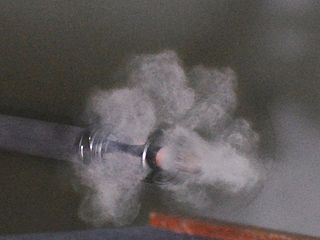
A flash suppressor, also known as a flash guard, flash eliminator, flash hider, or flash cone, is a muzzle device attached to the muzzle of a rifle that reduces its visible signature while firing by cooling or dispersing the burning gases that exit the muzzle, a phenomenon typical of carbine-length weapons. Its primary intent is to reduce the chances that the shooter will be blinded in low-light shooting conditions. Contrary to popular belief, it is only a minor secondary benefit if a flash suppressor reduces the intensity of the flash visible to the enemy.
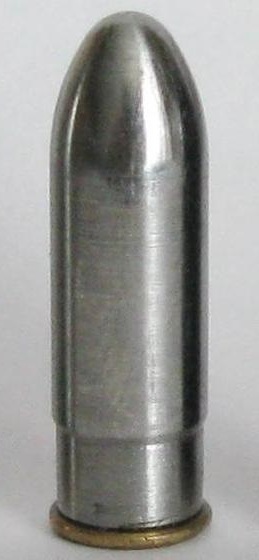
Caseless ammunition (CL), or caseless cartridge, is a configuration of weapon-cartridge that eliminates the cartridge case that typically holds the primer, propellant and projectile together as a unit. Instead, the propellant and primer are fitted to the projectile in another way so that a cartridge case is not needed, for example inside or outside the projectile depending on configuration.

A gun barrel is a crucial part of gun-type weapons such as small firearms, artillery pieces, and air guns. It is the straight shooting tube, usually made of rigid high-strength metal, through which a contained rapid expansion of high-pressure gas(es) is used to propel a projectile out of the front end (muzzle) at a high velocity. The hollow interior of the barrel is called the bore, and the diameter of the bore is called its caliber, usually measured in inches or millimetres.

The Gyrojet is a family of unique firearms developed in the 1960s named for the method of gyroscopically stabilizing its projectiles. Rather than inert bullets, Gyrojets fire small rockets called Microjets which have little recoil and do not require a heavy barrel or chamber to resist the pressure of the combustion gases. Velocity on leaving the tube was very low, but increased to around 1,250 feet per second (380 m/s) at 30 feet (9.1 m). The result is a very lightweight and transportable weapon.
Blowback is a system of operation for self-loading firearms that obtains energy from the motion of the cartridge case as it is pushed to the rear by expanding gas created by the ignition of the propellant charge.
Obturation is the necessary barrel blockage or fit in a firearm or airgun created by a deformed soft projectile. A bullet or pellet made of soft material and often with a concave base will flare under the heat and pressure of firing, filling the bore and engaging the barrel's rifling. The mechanism by which an undersized soft-metal projectile enlarges to fill the barrel is, for hollow-base bullets, expansion from gas pressure within the base cavity and, for solid-base bullets, "upsetting"—the combined shortening and thickening that occurs when a malleable metal object is struck forcibly at one end.

The VP70 is a 9×19mm, 18-round, double action only, semi-automatic/three-round burst capable polymer frame pistol manufactured by German arms firm Heckler & Koch GmbH. VP stands for Volkspistole, and the designation 70 was for the first year of production, 1970.

Gas-operation is a system of operation used to provide energy to operate locked breech, autoloading firearms. In gas-operation, a portion of high-pressure gas from the cartridge being fired is used to power a mechanism to dispose of the spent case and insert a new cartridge into the chamber. Energy from the gas is harnessed through either a port in the barrel or a trap at the muzzle. This high-pressure gas impinges on a surface such as a piston head to provide motion for unlocking of the action, extraction of the spent case, ejection, cocking of the hammer or striker, chambering of a fresh cartridge, and locking of the action.
This article explains terms used for the British Armed Forces' ordnance (weapons) and ammunition. The terms may have different meanings depending on its usage in another country's military.
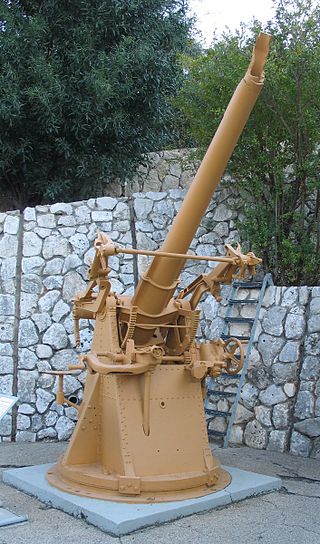
A squib load, also known as a squib round, pop and no kick, or just a squib, is a firearm malfunction in which a fired projectile does not have enough force behind it to exit the barrel, and thus becomes stuck. This type of malfunction can be extremely dangerous, as failing to notice that the projectile has become stuck in the barrel may result in another round being fired directly into the obstructed barrel, resulting in a catastrophic failure of the weapon's structural integrity.
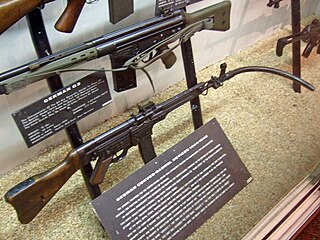
The Krummlauf is a bent barrel attachment for the Sturmgewehr 44 rifle developed by Germany in World War II. The curved barrel included a periscope sighting device for shooting around corners from a safe position.
The following are terms related to firearms and ammunition topics.
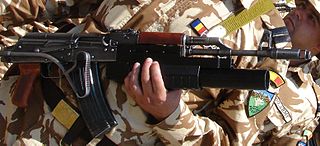
The Pușcă Automată model 1986 is the standard assault rifle used by the Romanian Military Forces and manufactured in Cugir, Romania by the ROMARM firm, located in Bucharest. The export name for this variant is the AIMS-74.

A silencer, also known as a sound suppressor, suppressor, or sound moderator, is a muzzle device that suppresses the blast created when a gun is discharged, thereby reducing the acoustic intensity of the muzzle report and jump, by modulating the speed and pressure of the propellant gas released from the muzzle. Like other muzzle devices, a silencer can be a detachable accessory mounted to the muzzle, or an integral part of the barrel.

9mm P.A., 9×22mm or 9mm P.A.K. is a firearm cartridge for a non-lethal gas pistol noisemaking gun. Caliber 9mm P.A. includes various blank, gas or rubber ammunitions made for different use.














